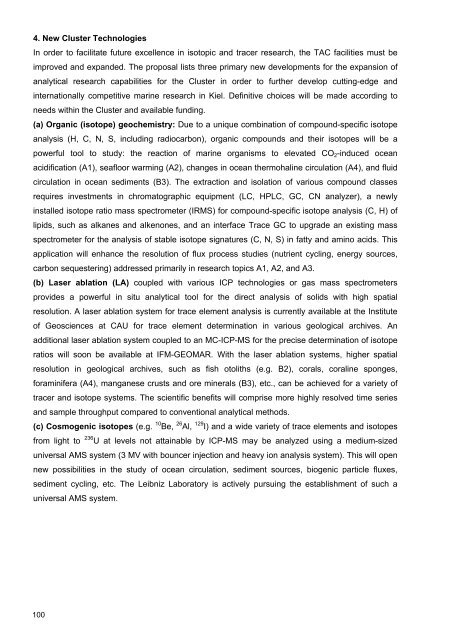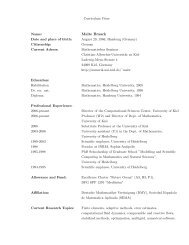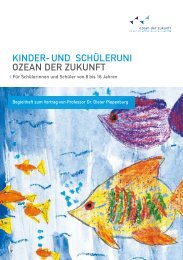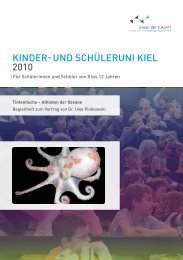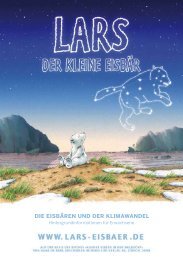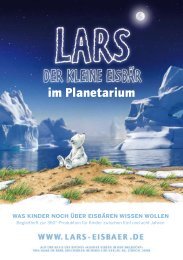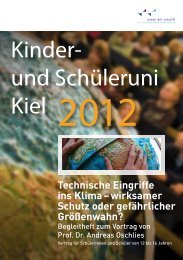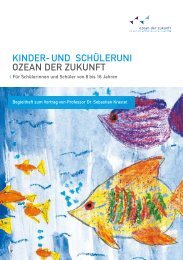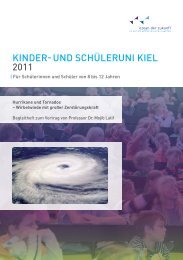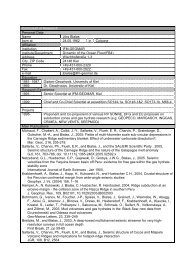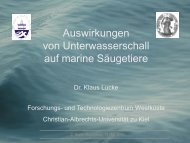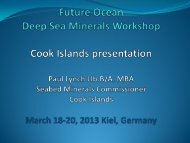Untitled - The Future Ocean
Untitled - The Future Ocean
Untitled - The Future Ocean
- No tags were found...
You also want an ePaper? Increase the reach of your titles
YUMPU automatically turns print PDFs into web optimized ePapers that Google loves.
4. New Cluster TechnologiesIn order to facilitate future excellence in isotopic and tracer research, the TAC facilities must beimproved and expanded. <strong>The</strong> proposal lists three primary new developments for the expansion ofanalytical research capabilities for the Cluster in order to further develop cutting-edge andinternationally competitive marine research in Kiel. Definitive choices will be made according toneeds within the Cluster and available funding.(a) Organic (isotope) geochemistry: Due to a unique combination of compound-specific isotopeanalysis (H, C, N, S, including radiocarbon), organic compounds and their isotopes will be apowerful tool to study: the reaction of marine organisms to elevated CO 2 -induced oceanacidification (A1), seafloor warming (A2), changes in ocean thermohaline circulation (A4), and fluidcirculation in ocean sediments (B3). <strong>The</strong> extraction and isolation of various compound classesrequires investments in chromatographic equipment (LC, HPLC, GC, CN analyzer), a newlyinstalled isotope ratio mass spectrometer (IRMS) for compound-specific isotope analysis (C, H) oflipids, such as alkanes and alkenones, and an interface Trace GC to upgrade an existing massspectrometer for the analysis of stable isotope signatures (C, N, S) in fatty and amino acids. Thisapplication will enhance the resolution of flux process studies (nutrient cycling, energy sources,carbon sequestering) addressed primarily in research topics A1, A2, and A3.(b) Laser ablation (LA) coupled with various ICP technologies or gas mass spectrometersprovides a powerful in situ analytical tool for the direct analysis of solids with high spatialresolution. A laser ablation system for trace element analysis is currently available at the Instituteof Geosciences at CAU for trace element determination in various geological archives. Anadditional laser ablation system coupled to an MC-ICP-MS for the precise determination of isotoperatios will soon be available at IFM-GEOMAR. With the laser ablation systems, higher spatialresolution in geological archives, such as fish otoliths (e.g. B2), corals, coraline sponges,foraminifera (A4), manganese crusts and ore minerals (B3), etc., can be achieved for a variety oftracer and isotope systems. <strong>The</strong> scientific benefits will comprise more highly resolved time seriesand sample throughput compared to conventional analytical methods.(c) Cosmogenic isotopes (e.g. 10 Be, 26 Al, 129 I) and a wide variety of trace elements and isotopesfrom light to 236 U at levels not attainable by ICP-MS may be analyzed using a medium-sizeduniversal AMS system (3 MV with bouncer injection and heavy ion analysis system). This will opennew possibilities in the study of ocean circulation, sediment sources, biogenic particle fluxes,sediment cycling, etc. <strong>The</strong> Leibniz Laboratory is actively pursuing the establishment of such auniversal AMS system.100


